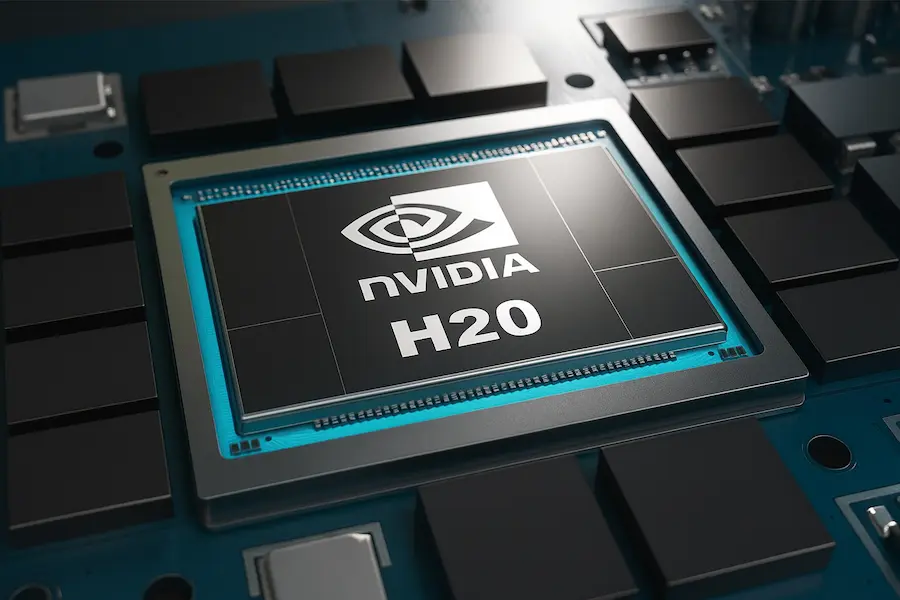Introduction: NVIDIA H20 chip: A Controversial Tech Pivot
In 2025, the U.S. Commerce Department reversed its earlier ban, allowing NVIDIA to resume sales of its H20 artificial intelligence chips to China. This decision, while celebrated by some in the tech sector, has sparked intense criticism from both Republican and Democratic lawmakers, as well as former national security officials.
At the heart of the debate is this: Is the U.S. playing a smart, strategic game to maintain global influence or making a critical mistake by empowering a technological rival?
Background: The U.S.-China AI Chip Tensions
Since 2019, the U.S. has implemented strict export controls to prevent China from accessing advanced semiconductors. These chips fuel AI development, and by extension, technologies that could be weaponized like surveillance systems, hypersonic weapons, or autonomous drones.
The H20 chip, although less powerful than NVIDIA H20 chip’s flagship H100, is still a capable accelerator for enterprise-level AI. It was designed to meet compliance under Biden-era export rules, including the AI Diffusion Rule, which restricted sales of chips with potential military applications.
However, the landscape shifted when NVIDIA CEO Jensen Huang met with President Donald Trump in early July 2025. Huang announced that the company would resume H20 shipments to China with the Commerce Department’s approval.
What Is the H20 Chip and Why It’s Controversial
The NVIDIA H20 chip is a high-performance GPU designed for artificial intelligence training and inference. It’s a “downgraded” version of banned chips, created specifically to comply with U.S. export laws.
However, national security experts argue that:
- It still provides considerable AI computing power
- It could boost China’s military and surveillance capabilities
- It undermines the original intent of tech containment policy
[Insert Visual: Chip Comparison – H100 vs H20 vs China’s SMIC AI chip]
Despite being technically legal, critics say the chip is “compliance theater” appearing to follow the rules while still giving China what it needs to advance its AI ecosystem.
Lawmakers and Experts Push Back
On July 28, 2025, 20 former national security officials sent a joint letter to Commerce Secretary Howard Lutnick, warning:
“The H20 chip is a potent accelerator of China’s frontier AI capabilities… By supplying these chips, we’re fueling the very infrastructure that could be used to modernize and expand the Chinese military.”
Among the signatories were:
- Matt Pottinger (Former Deputy National Security Advisor under Trump)
- Diana Banks Thompson (Obama-era Defense official)
Rep. Raja Krishnamoorthi (D-Ill.) and Rep. John Moolenaar (R-Mich.) also expressed bipartisan concern. Moolenaar emphasized that chip bans should consider China’s current capabilities, not just U.S. benchmarks.
Related Reading: How the AI Diffusion Rule Shapes Export Policy →
NVIDIA H20 chip Defense: Economic Strategy, Not Military Risk
NVIDIA H20 chip responded to the backlash by defending the H20 chip’s purpose. In a statement to Nextgov/FCW, a company spokesperson said:
“The H20 chips will not enhance anyone’s military capabilities but will help America win the support of developers worldwide.”
Commerce Secretary Howard Lutnick added in a CNBC interview:
“You want to sell the Chinese enough that their developers get addicted to the American technology stack.”
In essence, the U.S. strategy is to retain soft power and influence not by denying China access altogether, but by keeping them dependent on American chips.
The Bigger Game: Economic Power vs. Security Risk
This situation is more than a tech deal it’s a tactical move in the global AI arms race.
Proponents argue:
- Blocking all chips may push China to develop its own tech faster
- Selling limited chips lets the U.S. monitor and influence AI development in China
Critics argue:
- Even compliant chips like the NVIDIA H20 chip give China a leg up
- Tech dependency is not a reliable long-term deterrent
- Rare earth mineral trade-offs may have influenced the decision
Also Read: Rare Earth Leverage: How China’s Supply Chain Dominance Influences U.S. Tech Policy
What Happens Next?
The story is still unfolding. Here’s what to watch:
- Congressional oversight is increasing new legislation may tighten export loopholes.
- Tech firms may face new auditing requirements for high-risk chip exports.
- China may retaliate by restricting rare earth supplies or pushing forward AI chip development at home.
- AI developers worldwide are watching to see how this affects access, trust, and supply chains.
Conclusion: A Defining Moment in U.S.-China Tech Policy
The H20 export saga is a reminder of how tech policy, national security, and economics are deeply intertwined. While NVIDIA sees the deal as a smart way to maintain global dominance, critics view it as a strategic blind spot.
This decision may shape how the world builds and controls AI and who ultimately leads in the next era of innovation.
FAQ (Schema Ready)
Q1: Why was NVIDIA H20 chip banned originally?
Due to U.S. export controls aimed at limiting China’s access to military-capable AI chips.
Q2: What is the AI Diffusion Rule?
A U.S. policy that restricts the export of AI chips based on performance and potential dual-use applications.
Q3: Why is the NVIDIA H20 chip chip controversial?
Because it’s technically compliant but still powerful enough to advance China’s AI capabilities.
Q4: Is NVIDIA violating U.S. law by selling NVIDIA H20 chip to China?
No, the chip meets current export criteria. However, critics argue it violates the spirit of the law.
READ ALSO:5 Powerful Ways Tecnoregio News is Revolutionizing Regional Economies with AI & Green Tech

